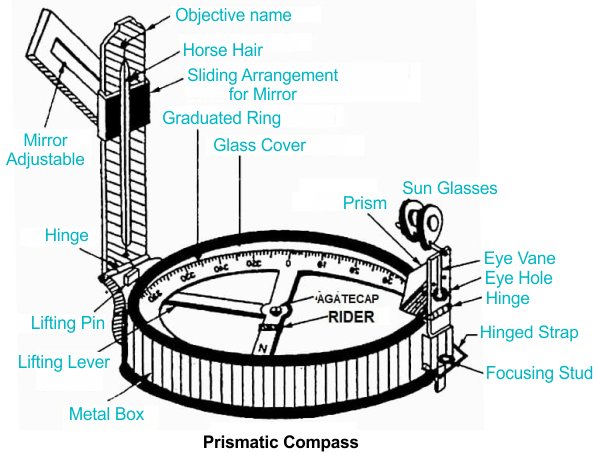
Exploring The Prismatic Compass: Guide And Usage Tips
A prismatic compass is a remarkable tool that revolutionized navigation. Its simple yet ingenious design allows for precise and reliable measurements in the field. With a prismatic compass in hand, explorers and surveyors can confidently chart their course with unparalleled accuracy. This instrument, with its compact size and ease of use, has become an indispensable companion for those traversing unknown terrain. Join us as we delve into the fascinating world of the prismatic compass and explore its diverse applications in our modern age.
Exploring the Wonderful World of Prismatic Compass
Welcome, young explorers! Today, we are going on an exciting journey to discover the amazing prismatic compass. Have you ever wondered how explorers, adventurers, and even engineers find their way around without getting lost? Well, the answer lies in this magical tool called the prismatic compass.
What is a Prismatic Compass?
A prismatic compass is a special type of compass that is used to determine direction, typically used in navigation, surveying, and mapping. It consists of a magnetic needle that aligns itself with the Earth’s magnetic field, allowing users to find true north.
But what sets the prismatic compass apart from a regular compass is its unique design. The prismatic compass features a prism that allows users to read the compass dial and take accurate readings without having to hold the compass directly in front of them.
How Does a Prismatic Compass Work?
Now, let’s delve into the inner workings of the prismatic compass. The main component of the prismatic compass is the magnetic needle, which is a thin, magnetized rod that is free to rotate. When the compass is held flat and steady, the magnetic needle aligns itself with the Earth’s magnetic field, pointing towards the magnetic north pole.
Next, we have the compass dial, which is marked with degrees from 0 to 360, representing the four cardinal directions – north, east, south, and west. The user can read the direction by aligning the prism with the compass dial and looking through it to see where the magnetic needle points.
The Importance of True North
One of the most crucial aspects of using a prismatic compass is finding true north. True north is the direction towards the geographic North Pole, as opposed to magnetic north, which is the direction towards the Earth’s magnetic pole. Knowing the difference between true north and magnetic north is essential for accurate navigation and mapping.
By using a prismatic compass to find true north, explorers and surveyors can plot accurate maps, navigate through unfamiliar terrain, and ensure they reach their destination safely.
Applications of Prismatic Compass
Prismatic compasses have a wide range of applications across various fields. Let’s explore some of the ways in which this remarkable tool is used:
Navigation
In the world of exploration and adventure, a prismatic compass is an indispensable tool for finding direction in unknown territories. Mountaineers, hikers, and sailors rely on prismatic compasses to navigate through challenging terrain and rough seas.
Surveying
Surveyors use prismatic compasses to measure angles and bearings when mapping out land, constructing buildings, or laying out roads. The precision and accuracy of prismatic compasses make them invaluable in the field of surveying.
Military and Defense
The military often utilizes prismatic compasses for tactical operations, reconnaissance, and map reading. Soldiers are trained to use prismatic compasses to move stealthily through unfamiliar landscapes and execute strategic maneuvers.
How to Use a Prismatic Compass
Now that we understand the importance of the prismatic compass, let’s learn how to use this fascinating tool:
Step 1: Holding the Compass
Hold the prismatic compass flat in front of you with the direction of travel arrow pointing straight ahead. Ensure that the compass is level and not tilted to get accurate readings.
Step 2: Aligning the Prism
Rotate the bezel ring on the compass to align the prism with the compass dial. Look through the prism to see the magnetic needle and the direction it points towards on the compass dial.
Step 3: Taking a Reading
To take a reading, note the degree marking on the compass dial where the magnetic needle points. This reading indicates the direction you are facing, allowing you to navigate accurately.
Exploring the World with Prismatic Compass
As we come to the end of our journey into the world of prismatic compasses, I hope you have gained a newfound appreciation for this remarkable tool. Whether you are a budding explorer, a curious student, or simply someone fascinated by the mysteries of navigation, the prismatic compass offers endless possibilities for discovery and adventure.
So, the next time you embark on a journey into the unknown, remember to bring along your trusty prismatic compass and let it guide you towards new horizons and exciting discoveries. Happy exploring!
Lensatic vs Prismatic compass – what is the difference
Frequently Asked Questions
What is a prismatic compass?
A prismatic compass is a navigation tool used for finding precise directional bearings, commonly used in surveying, engineering, and mining. It consists of a magnetic compass needle enclosed in a glass-faced compass with a prism to read the bearing accurately.
How do you use a prismatic compass for navigation?
To use a prismatic compass for navigation, you hold it level and steady, then align the compass with the desired object by looking through the prism. The bearing is then read directly through the prism, providing accurate directional information.
What are the advantages of using a prismatic compass in surveying?
Using a prismatic compass in surveying offers several advantages, including its precision in determining bearings, ease of use in taking quick and accurate readings, and its portability for fieldwork without the need for additional equipment.
Can a prismatic compass be affected by external magnetic influences?
Yes, a prismatic compass can be influenced by external magnetic forces such as metal objects, power lines, or electronic devices. It is essential to use the compass in an area free from magnetic interference to ensure accurate readings.
How do you maintain and calibrate a prismatic compass?
To maintain a prismatic compass, keep it clean and free from dust or debris that can affect its accuracy. Calibrating involves ensuring the needle points to true north by adjusting the declination or using known reference points to correct any deviation. Regular calibration is essential for reliable navigation readings.
Final Thoughts
In conclusion, the prismatic compass is an essential tool for precise directional measurement in various fields. Its compact design and accuracy make it a trusted instrument for navigation, surveying, and outdoor activities. With its ability to provide quick and reliable readings, the prismatic compass remains a valuable asset for professionals and enthusiasts alike. Embrace the efficiency and reliability of the prismatic compass in your next adventure.



